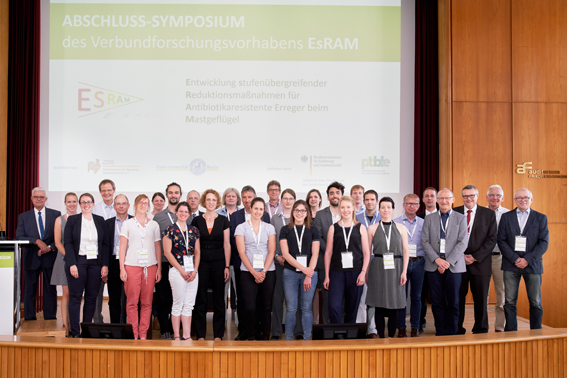Promising insights into antibiotic resistance

How can the occurrence of antibiotic-resistant pathogens in the entire chicken meat production chain be reduced as best as possible? The EsRAM* research network under the scientific direction of the Freie Universität Berlin and with the Central Association of the German Poultry Industry (ZDG) as the main economic partner has addressed this key question over the past three years (*EsRAM stands for the development of step-by-step reduction measures for antibiotic-resistant pathogens in fattening poultry). At the final symposium in Berlin, the scientists presented their innovative and practice-oriented results to around 150 guests and discussed options for action for the future.
"Reducing resistance is extremely important - the poultry industry wants to make a contribution"
“Reducing antibiotic resistance is extremely important – for veterinary medicine as well as for human medicine. As the German poultry industry, we want to make an active and important contribution here," says ZDG President Friedrich-Otto Ripke, explaining the poultry industry's intensive commitment to this research project. In seven work packages, EsRAM has examined every link in the chicken meat production chain, always looking for solutions to reduce the occurrence and transmission of antibiotic-resistant germs such as MRSA and ESBL-producing E. coli. The scientific management of the project lies with Prof. Dr. Uwe Rösler from the Institute for Animal and Environmental Hygiene at Freie Universität Berlin. He describes the holistic approach of the project, which is funded by the Federal Ministry of Food and Agriculture with around 2,5 million euros: "We have researched across stages - from the hatchery level to fattening to slaughter and processing. And the project has produced important insights in every area that can be translated into practical, effective measures.”
Particularly promising: "Competitive Exclusion" cultures - but: Approval is missing
EsRAM has produced particularly promising findings in the prophylactic use of so-called "Competitive Exclusion" cultures (CE) on chicks. The researchers have shown that this method can significantly reduce colonization of the intestines with antibiotic-resistant germs and that stable animal health is ensured through significantly improved defenses in the intestines. The problem, however, is that the legal basis in Germany does not currently allow the use of CE cultures. "We urgently need a socio-political discussion about effective and goal-oriented processes that are not yet approved in Germany," both ZDG President Ripke and EsRAM Director Prof. Rösler demanded several times during the EsRAM final symposium.
Stocking density, breed and length of fattening play only a minor role in resistance
EsRAM has good news for spreading poultry manure on agricultural land: The researchers have found that when poultry manure is stored, composted or fermented properly, no significant amounts of resistant germs are spread. And this is also an unexpected result: Factors such as stocking density or breed and length of fattening play only a minor role in the colonization of chickens with MRSA and ESBL-producing E. coli. Other EsRAM sub-projects dealt with hatching egg disinfection, the use of probiotics and other measures at fattening, slaughtering and processing level.
Praise from politicians - Connemann: "Initiating EsRAM was a heroic act"
The promising approaches of the research were discussed by EsRAM director Prof. Rösler and ZDG President Ripke in the concluding panel discussion with Gitta Connemann MdB, the deputy chairman of the CDU/CSU parliamentary group, and Prof. Dr. Karsten Nöckler from the Federal Institute for Risk Assessment (BfR). "Initiating EsRAM was a heroic act," Gitta Connemann expressly praised the commitment of the poultry industry and the holistic research approach. "Exemplary, extraordinary and so far unique in Germany" is the view of the research project, which is deliberately directed at the entire production chain, "an excellent investment to sharpen the view of politics", which has so far almost exclusively pursued a quantitative approach to the topic of antibiotic use and resistance . "Where do we have to open doors?" asked Connemann, also self-critically in the direction of politics - but at the same time he feared that the approval of CE cultures would be "a big deal". On behalf of the BfR, Prof. Dr. Karsten Nöckler emphasized the need to find solutions for society as a whole: "With EsRAM, we have developed alternatives to significantly reduce resistance," he emphasized. "Now we have to work together to successfully resolve the issue of approval."
Putting scientific knowledge into practice – action plan by the end of the year
What is the next step after the valuable insights gained from the EsRAM project? For the German poultry industry, ZDG President Ripke announced that he would set up a ZDG specialist group to develop an action plan to put EsRAM findings into practice: "We are grateful for the important results that EsRAM has produced and are doing everything we can to put this knowledge into practice. By the end of this year we will have worked out practical solutions.”
More information about the EsRAM project: www.esram-symposium.de

The participants in the EsRAM joint research project with the scientific director Prof. Dr. Uwe Rösler (3rd from right) and Friedrich-Otto Ripke (left), President of the Central Association of the German Poultry Industry e. V. (ZDG) as the main economic partner.
About the ZDG
The Central Association of the German poultry industry e. V. represents as a trade roof and top organization, the interests of the German poultry industry at national and EU level towards political, official and professional organizations, the public and abroad. The approximately 8.000 members are organized in federal and state associations.
